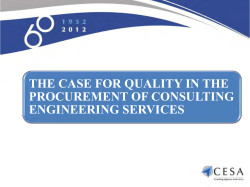
PDCA Cycle
PDCA for Dummies Fishingen EQuiP open conference 23-‐25.04.2015 FIVE PRINCIPLES OF QI 1. Quality improvement is the science of process management. 2. If you cannot measure it…You cannot improve it. 3. Managed care means managing the processes of care, not managing physicians and nurses. 4. The right data in the right format at the right Jme in the right hands. 5. Engaging the “smart cogs” of healthcare. Quality Improvement is about “Change” • To improve you have to change but not all change is improvement ! • A way to change is by seVng up a QI-‐project. • Say what you will do, do what you said and prove it! PDCA CYCLE PLAN • Task: – Define and analyse a problem and idenJfy the root cause • Methods: – Brainstroming – Nominal technique – Pareto diagram – Fishbone diagram – ….... q F ind Problem q O rganise meeting q C larify problem q U ncover problems q S elect a strategy/Start PDCA Find the opportunity for QI • • • • • • • PaJents: complaints remarks Daily pracJce: losing Jme, geVng angry, ….. Peers: doing things different, quality circles External feed back: New knowledge: guidelines, New regulaJons or legislaJon ….. KISS § Keep It § Simple: § Small: it is not about scientific research ! The kiss, August Rodin Organise meeting q Who are the stakeholders? q Make sure all possible partners participate from the beginning: – Better insight in the problem – More idea’s about possible actions – People have to become owner of the process in which they are involved – Higher motivation – Easier to delegate tasks Clarify q Consensus about the exact problem: what is it all about ! q Makes sure that everybody is working in the same direction q Keep to measurable things q Formulate your problem/the ambition of your project in 1 sentence Clarify • Not: “we will opJmize diabeJc care in our pracJce” • But: “not enough diabeJc paJents get yearly foot controled” Understand/Uncover • Making your process visible • Measuring your proces • Cause root analysis Making your process visible 1 guideline implementaJon step 1 How do we do it now ? step 2 Mirror against exisJng guidlines and see the differences step 3 discuss differences step 4 develop a pracJce guideline step 5 make the guideline available in the pracJce Making your process visible Make a flow chart 1. Start of a procedure 2. Steps within the proces 3. A decision or a choice no yes 4. Documents/measurements document 5. End of a proces measurement Flow chart "aanvraag huisbezoek" Aanvraag Dringend? Raadpleging ja Werk vs permanenJe ja neen Raadpleging mogelijk? neen Noteren agenda Wie gaat? Huisbezoek PaJëntenoverleg Measuring Measuring: PRACTICAL EXAMPLE • Quality measure: – WaiJng Jme in minutes • Quality indicator: – WaiJng Jme is 20 minutes or less • Quality standard: – More than 70% of paJents wait for 20 minutes or less Cause root analysis Swiss Cheese Model of Defences (Reason) No policy for INR blood tests Latent failures at the managerial levels Psychological precursors Physician stressed: daughter‘s birthday High INR not noticed Unsafe acts (active failures) Local triggers Intrinsic defects Atypical conditions Lab Patient Nurse Defences-in-depth Flu season Computer breakdown Critical event / accident Start • Make your plan • 80/20 rule • Tackle things you can do yourselves first • Be SMART SMART-principle q SPECIFIC : the target is clear q Measurable: q ACCEPTABle: q REALISTIC: q TIMELY Plan = q F ind Problem q O rganise meeting q C larify problem q U ncover problems q S elect a strategy/Start PDCA PDCA CYCLE DO • Task: – Devise a soluJon – Develop detailed acJon – Plan and implement it systemaJcally CHECK • Task: – Confirm outcomes against plan – IdenJfiy deviaJons and issues • Methods: – Survey – PaJents‘ charts analysis – ObservaJon – Peer review Act q ABANDONING q ADOPTING q ADJUSTING AdopJng • Task: – Standardize soluJon – Review and define next issues • Methods: – Planning – Inclusion of all parJcipants in the process – SJmulaJon CONTINUOUS QI WITH PDCA CYCLE
© Copyright 2025











